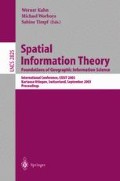Abstract
When describing routes in urban environments, speakers usually refer to both street names and visual landmarks. However, a navigational system can be designed which only refers to streets or, alternatively, only to landmarks. Does it make any difference which type of information users are provided with? The answer to this question is crucial for the design of navigational aids. We report two experiments. The first one showed that in a wayfinding task, route directions referring to streets were less effective than those referring to landmarks for guidance purposes. The second experiment showed that when people generate route directions, they tend to produce less street than landmark information. These studies provide a further illustration of the critical role of landmarks in route directions.
This research was supported by a doctoral research grant from the Délégation Générale pour l’Armement (DGA).
Access this chapter
Tax calculation will be finalised at checkout
Purchases are for personal use only
Preview
Unable to display preview. Download preview PDF.
References
Allen, G.L.: Principles and practices for communicating route knowledge. Applied Cognitive Psychology 14, 333–359 (2000)
Bahrick, H.P.: The cognitive map of a city: Fifty years of learning and memory. In: Bower, G.H. (ed.) The psychology of learning and motivation: Advances in research and theory, pp. 125–163. Academic Press, New York (1983)
Bell, A.B., Greene, T.C., Fischer, J.D., Baum, A.: Environmental psychology. Harcourt Brace College Publishers, Fort Worth (1996)
Cohen, G., Burke, D.M.: Memory for proper names: A review. Memory 1, 249– 263 (1993)
Cornell, E.H., Heth, C.D., Kneubuhler, Y., Sehgal, S.: Serial position effects in children’s route reversal errors: Implications for police search operations. Applied Cognitive Psychology 10, 301–326 (1996)
Cornell, E.H., Heth, C.D., Skoczylas, M.J.: The nature and use of route expectancies following incidental learning. Journal of Environmental Psychology 19, 209–229 (1999)
Daniel, M.-P., Tom, A., Manghi, E., Denis, M.: Testing the value of route directions through navigational performance. In: Spatial Cognition and Computation (in press)
Denis, M.: The description of routes: A cognitive approach to the production of spatial discourse. Current Psychology of Cognition 16, 409–458 (1997)
Denis, M., Pazzaglia, F., Cornoldi, C., Bertolo, L.: Spatial discourse and navigation: An analysis of route directions in the city of Venice. Applied Cognitive Psychology 13, 145–174 (1999)
Fontaine, S., Denis, M.: The production of route instructions in underground and urban environments. In: Freksa, C., Mark, D.M. (eds.) COSIT 1999. LNCS, vol. 1661, pp. 83–94. Springer, Heidelberg (1999)
Galea, L.A.M., Kimura, D.: Sex differences in route learning. Personality and Individual Differences 14, 53–65 (1993)
Golledge, R.G.: Geographical perspectives on spatial cognition. In: Gärling, T., Golledge, R.G. (eds.) Behavior and environment: Psychological and geographical approaches, pp. 16–46. North Holland, Amsterdam (1993)
Heth, C.D., Cornell, E.H., Alberts, D.M.: Differential use of landmarks by 8- and 12-year-old children during route reversal navigation. Journal of Environmental Psychology 17, 199–213 (1997)
Ioerger, T.R.: The manipulation of images to handle indeterminacy in spatial reasoning. Cognitive Science 18, 551–593 (1994)
Izaute, M.: De la dénomination: la spécificité des noms propres. L’Année Psychologique 99, 731–751 (1999)
Kalakoski, V., Saariluoma, P.: Taxi drivers’ exceptional memory of streets names. Memory and Cognition 29, 634–638 (2001)
Kirasic, K.C., Mathes, E.A.: Effects of different means for conveying environmental information on elderly adults’ spatial cognition and behavior. Environment and Behavior 22, 591–607 (1990)
Mani, K., Johnson-Laird, P.N.: The mental representation of spatial descriptions. Memory & Cognition 10, 181–187 (1982)
Michon, P.-E., Denis, M.: When and why referring to visual landmarks in direction giving? In: Montello, D.R. (ed.) COSIT 2001. LNCS, vol. 2205, pp. 292–305. Springer, Heidelberg (2001)
Nothegger, C.: Automatic selection of landmarks. Unpublished master’s thesis (Diplomarbeit), Vienna Technical University, Vienna, Austria (2003)
Raubal, M., Winter, S.: Enriching wayfinding instructions with local landmarks. In: Egenhofer, M.J., Mark, D.M. (eds.) GIScience 2002. LNCS, vol. 2478, pp. 243–259. Springer, Heidelberg (2002)
Rossano, M.J., Reardon, W.P.: Goal specificity and the acquisition of survey knowledge. Environment and Behavior 31, 395–412 (1999)
Schneider, L.F., Taylor, H.A.: How do you get there from here? Mental representations of route descriptions. Applied Cognitive Psychology 13, 415–441 (1999)
Streeter, L.A., Vitello, D., Wonsiewicz, S.A.: How to tell people where to go: Comparing navigational aids. International Journal of Man-Machine Studies 22, 549–562 (1985)
Taylor, H.A., Naylor, S.J., Chechile, N.A.: Goal-specific influences on the representation of spatial perspective. Memory and Cognition 27, 309–319 (1999)
Taylor, H.A., Tversky, B.: Spatial mental models derived from survey and route descriptions. Journal of Memory and Language 31, 261–292 (1992)
Thorndyke, P.W., Hayes-Roth, B.: Differences in spatial knowledge acquired from maps and navigation. Cognitive Psychology 14, 560–589 (1982)
Author information
Authors and Affiliations
Editor information
Editors and Affiliations
Rights and permissions
Copyright information
© 2003 Springer-Verlag Berlin Heidelberg
About this paper
Cite this paper
Tom, A., Denis, M. (2003). Referring to Landmark or Street Information in Route Directions: What Difference Does It Make?. In: Kuhn, W., Worboys, M.F., Timpf, S. (eds) Spatial Information Theory. Foundations of Geographic Information Science. COSIT 2003. Lecture Notes in Computer Science, vol 2825. Springer, Berlin, Heidelberg. https://doi.org/10.1007/978-3-540-39923-0_24
Download citation
DOI: https://doi.org/10.1007/978-3-540-39923-0_24
Publisher Name: Springer, Berlin, Heidelberg
Print ISBN: 978-3-540-20148-9
Online ISBN: 978-3-540-39923-0
eBook Packages: Springer Book Archive

